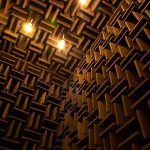
 Because decibel differences are difficult for most people to interpret, they often seek to describe noise improvements using a more practical yardstick: how much quieter it’s going to sound. That’s perfectly sensible. The problem starts when folks confuse the relationship between sound power, decibels, and perceived loudness.
Because decibel differences are difficult for most people to interpret, they often seek to describe noise improvements using a more practical yardstick: how much quieter it’s going to sound. That’s perfectly sensible. The problem starts when folks confuse the relationship between sound power, decibels, and perceived loudness.
Here are two examples:
- An engineer describes an aircraft whose propellers will spin at ½ speed relative to a helicopter. The engineer goes on to say that, because the noise emission goes as the 5th power of the tip speed, the aircraft’s sound power will be 1/32nd of the helicopter. So far, so good.
The interviewer misunderstands and, as a result, the article states that the aircraft will be “32 times quieter”. The reader will interpret that as a factor-of-32 reduction in perceived loudness. That’s not how it works.
There’s a risk that a listener comparing the two sounds would be underwhelmed by the actual result and react to the failure to achieve overblown expectations more than the otherwise impressive result. The credibility of noise control takes a hit.
- In the year 2000, leafblower sound pressure levels were typically 70 dBA at 50 ft. Recently, a new quieter leafblower was introduced into the commerical market at 59 dBA at 50 ft. An 11 dB reduction out of 70 is often mistakenly described as 16% (i.e., 11÷70), which substantially understates the actual improvement.
Noise control takes another hit when a skeptic observes that we “haven’t even achieved 1% loudness reduction per year”. A direct comparison of the sounds would give a pleasant surprise in this case. However there’s a risk that the reduction, stated incorrectly, appears so small that some might not even take the time to give a listen.
What’s really going on…
Recall that decibels are merely logarithmic shorthand for ratios of sound power. Eliminate 90% of the energy and the remainder (10%) is 10 dB less than the original. In the case of the aircraft, 31/32 of sound power has been eliminated and the remaining 1/32 sound power level is 15 dB less than the original.
But what about perceived loudness?
A 10 dB change is required to double or halve loudness for two sounds with similar spectra. This is a good thing, because the ratio of sound powers between barely discernable and the threshold of pain is about 1,000,000,000,000 to 1. The human brain compresses this enormous range into a manageable perceptual experience consisting of roughly 40 just-noticeable (3 dB) steps.
- The quieter aircraft (-15 dB) is actually about ⅓ as loud as the helicopter. This could also be stated as a 65% loudness reduction. That’s a significant improvement.
Personally, I think it would be confusing to advertise it as “3x as quiet”. By comparison, would it make sense to say that “most Americans are at least 100,000 times poorer than Jeff Bezos”? Same logical structure…..
- The newer leafblower’s improvement (-11 dBA) corresponds to about 50% quieter; roughly ½ as loud as its predecessors at a given distance. That’s also a significant improvement.
To measure the same loudness, you’d have to move about 3.5 times as far away from a vintage leafblower, which means the older one affects 12 times as much area, and presumably 12 times as many people!
A better way: sones
Loudness has it’s own dedicated unit, the sone, which has several advantages over decibels:
- it’s an actual unit corresponding to a fixed amount of sound pressure,
- it’s a linear quantity, and
- it takes into account loudness effects due to spectral shape.
For instance a sound with a loudness of 8 sone is always twice as loud as one with 4 sone. The only disadvantage is that loudness calculation is complex and requires special sound quality software. Perhaps someday all products will be rated in sones. Right now it’s an achievement just to get some economic sectors to properly measure, specify, and report decibel values. However many manufacturers (many of them Nelson Acoustics‘ clients) are already designing for low noise with sound quality in mind. You can typically immediately identify these products when you turn them on. Especially with a competitive unit nearby.
Conclusion
Of course loudness is only one characteristic of sound: you’ll likely have a preference between 6 sones of birdsong and 6 sones of distant chainsaw. But it’s often the most important characteristic, and a lot easier than juggling decibels. Measuring and reporting loudness is a large step in the right direction. In the meantime, be careful not to confuse sound power, decibels, and perceived loudness.
Copyright 2020 Nelson Acoustics
Previous entries in the series “Myths, Misunderstandings, and Magical Thinking about Noise”:
3. Careful with that dB Thermometer
4. The Forbidden Word – Soundproof
